By IAN FAILES
By IAN FAILES
If you’ve noticed that a raft of animated films, shows and visual effects projects have been toying with more hand-crafted effects animation lately, you’re not alone. There’s somewhat of a trend right now to go ‘old school’ on these big projects with what are often anime-inspired animated effects, away from being completely photorealistic. New – and even old – tools have been enabling more painterly approaches to elements such as explosions, lightning, laser fire, smears, speed lines, dust, trails and stylized 2D and 3D effects. Here, artists on several recent projects break down their work in this area.
Imageworks explores the finer FX details
With Spider-Man: Into the Spider-Verse, Sony Pictures Imageworks jumped head-first into a hand-drawn look approach, clearly inspired by the comic books. Many aspects combined for the hand-crafted feel, from line work on the characters, to speed lines, and also for elements such as explosions. In the final act of the film, these explosions were mostly hand-drawn elements crafted first by a 2D artist, as Imageworks FX Supervisor Pav Grochola outlines.

A final explosion shot by Sony Pictures Imageworks from Spider-Man: Into the Spider-Verse. (Image courtesy of Sony Pictures)

The hand-drawn explosion element. (Image courtesy of Sony Pictures)

The explosion element is brought into Houdini. (Image courtesy of Sony Pictures)

A frame from The Mitchells vs. The Machines where Imageworks continued using stylized techniques for the 3D-animated film. (Image courtesy of Sony Pictures)
“We would take in those hand-drawn elements and place them in Houdini on cards. That was combined with very carefully artistically-directed procedural rays that would augment and live within those cards. The 2D elements were split out into tones of color – a smoke tone, a smoke layer and a hotter layer. On top of that we had particles and debris played on 2s, so there were a lot of tricks that we used to try to make things look as convincingly hand-created as possible, including in compositing.”
“What we’re really doing here is ‘designing’ explosions,” Grochola notes. “That’s where 2D artists are really good. That’s what they do! They start from scratch with a piece of paper – from nothing – and they design it, whereas sometimes we are used to simulating things and not really knowing what the simulation did.”
“What we’re really doing here [on Spider-Man: Into the Spider-Verse] is ‘designing’ explosions. That’s where 2D artists are really good. That’s what they do! They start from scratch with a piece of paper – from nothing – and they design it, whereas sometimes we are used to simulating things and not really knowing what the simulation did.”
—Pav Grochola, FX Supervisor
Then, on The Mitchells vs. the Machines, Imageworks’ brief was to make the film look more like an illustrative novel. For instance, here explosions would begin with partial pyro simulations. Grochola says, “We advected particles through this basic pyro sim. These particles would become camera facing cards with brush stroke textures. This gave us a great base that looked illustrated, but also had the motion and color of the underlying simulation. The 2D artists would finally draw on top of this to further enhance the hand-drawn look.”
Going cute-chunky
Pixar’s Turning Red contains several hand-drawn-effects animation moments that follow what Production Designer Rona Liu had instilled as a “cute-chunky with a soft, lush color palette” for the film, according to FX artist Carl Kaphan. “This was the first Pixar movie, to my knowledge, that had a sketch artist – Lead Animator Rob Thompson – as a dedicated member of the effects team for the entire duration of production. Rob provided draw-overs, timing tests and concept art for much of the effects work across the film.”
One fantastical shot, dubbed ‘Men Man Mountain,’ sees the main character summon her teen idols. Pixar utilized a more hand-drawn feel to the final magical effects look. “The graphical elements and timing of the giant pink poof were roughed out with straight-ahead animation,” Kaphan explains, “with the drawings then brought into Houdini and converted into 3D geometry to be used for interactive lighting on the characters and environments and to help place the giant poof cloud in time and space. The hand-drawn images were also brought into Nuke where shot lighter Molly Meyer applied treatment to add a lustrous glow as well as adding a field of stylized stars.”
‘Panda poof’ effects in the film also took on 2D characteristics while leveraging Houdini effects sims. “To attain a dissipation that mimicked traditional animation,” Kaphan says, “we relied on subdividing the cloud shapes over time instead of decreasing the opacity. To get the timing to feel right, we ended up applying a modified power law distribution to vary the amount of time before each individual poof subdivides. To enhance the read of an appealing silhouette we often cheated the velocities to the camera plane. To add complexity, we used a combination of fluid simulated and hand-sculpted velocity fields to enhance the motion. Jordan Rempel, our Lighting Supervisor, assisted early on by applying multi-scattering approximation to the poofs in RenderMan which added a beautifully luminous glow.”
“[Turning Red] was the first Pixar movie, to my knowledge, that had a sketch artist – Lead Animator Rob Thompson – as a dedicated member of the effects team for the entire duration of production. Rob provided draw-overs, timing tests and concept art for much of the effects work across the film.”
—Carl Kaphan, FX Artist
A homage to the illustrative source
For The Bad Guys, based on the illustrated storybooks, DreamWorks Animation deliberately set out to mimic the hand-drawn imperfections and simplification of the scenes and characters. “One of our goals with visuals was to make all of our effects look like they were 100% 2D animated,” Visual Effects Supervisor Matt Baer advises. Baer notes that a sprite library broken down into sub-components in Houdini was developed for the film. “We also developed particle sim techniques that would be rendered in two-tones, so when we merged them together with the sprites, the audience, hopefully, couldn’t tell the difference where the sprite started and where the simulation began.”
Baer also notes that the requirements of The Bad Guys brought in new workflows, “ones that essentially allowed us to do 2D animation in a 3D application and take advantage of the scalability of the 3D application,” something DreamWorks had not ventured into in a major way at that point. A proprietary tool called Doodle helped achieve the desired look.
“It let us draw in screen space and position the Doodle geometry in 3D space,” Head of Look Jeff Budsberg says. “You could render those doodles directly as an impact or a liquid, you could render it in two-tone, or you could use that drawing to drive a 3D simulation. Even the lighting department was doing some of this sprite work for graphic camera flashes or speed lines encroaching on the frame or on a camera pan. We built these systems that could be interchanged between the departments, and the crux behind everything was all hand-drawn lines.”
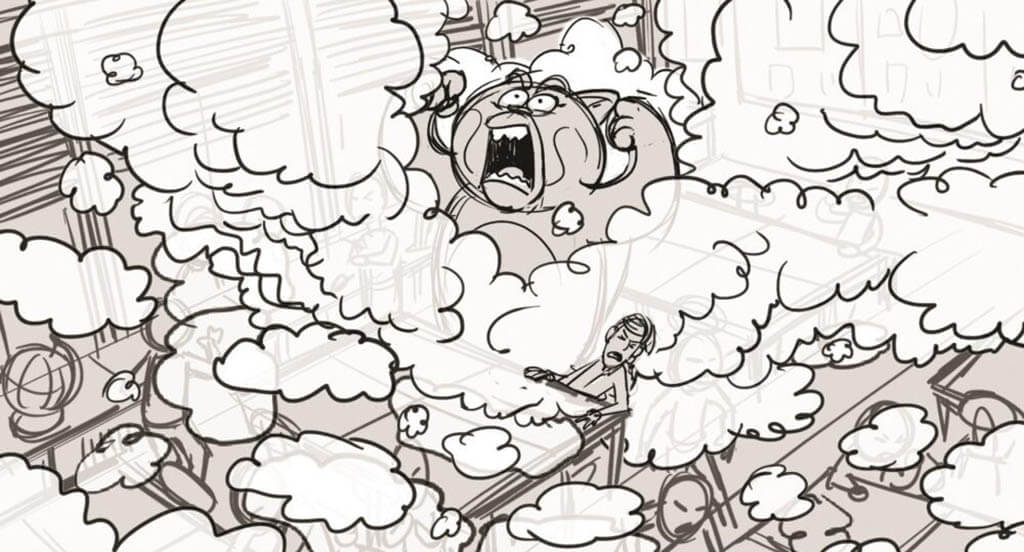
A storyboard from the ‘panda poof’ sequence in Turning Red. (Image courtesy of Disney/Pixar)
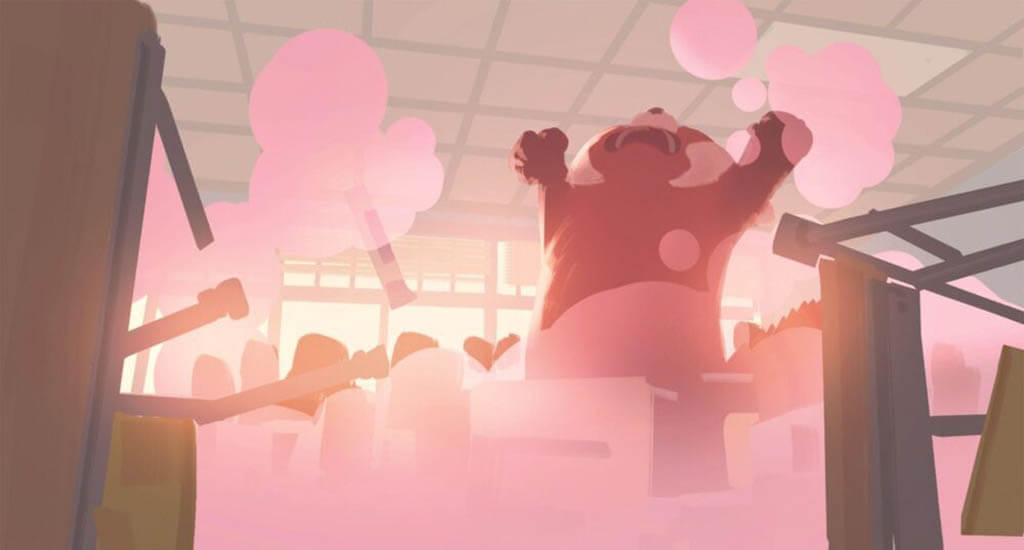
Early concept art for the shot. (Image courtesy of Disney/Pixar)

A layout frame where the Pixar team make framing and lens choices. (Image courtesy of Disney/Pixar)
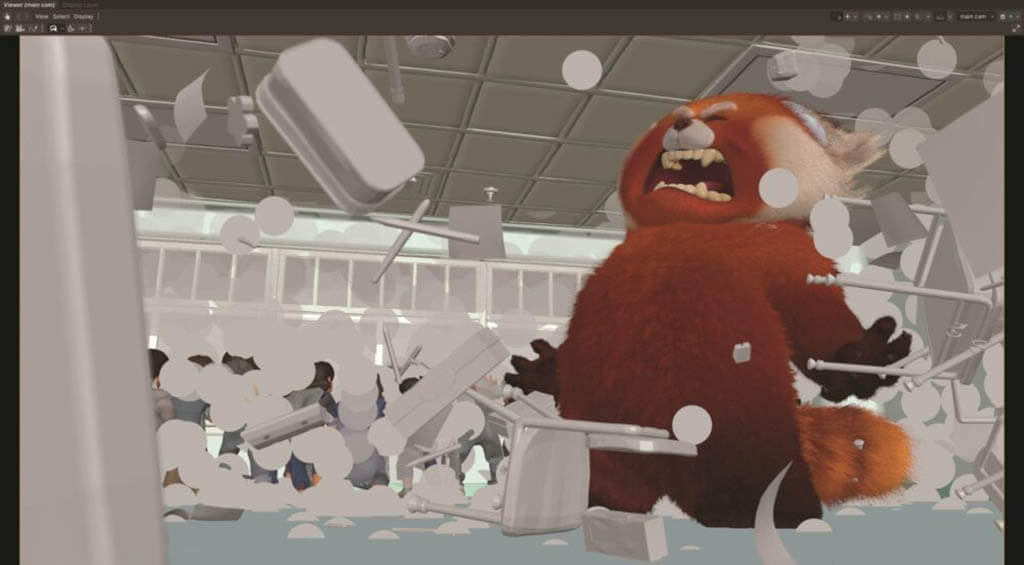
FX pass using proprietary software developed for the particular pink-smoke look called ‘pink vapor clouds.’ (Image courtesy of Disney/Pixar)

The final rendered shot. (Image courtesy of Disney/Pixar)
Pipelining 2d effects animation
Fortiche’s animated series Arcane made waves recently with its blending of graphic 2D and 3D styles. To help enable a 2D sensibility to be incorporated into what were often 3D scenes, the studio needed to adapt its existing pipeline for 2D work so that several tools were more closely integrated.

The Crimson Paw reveal scene in The Bad Guys made extensive use of stylized 2D animation combined with 3D. (Image courtesy of DreamWorks Animation)
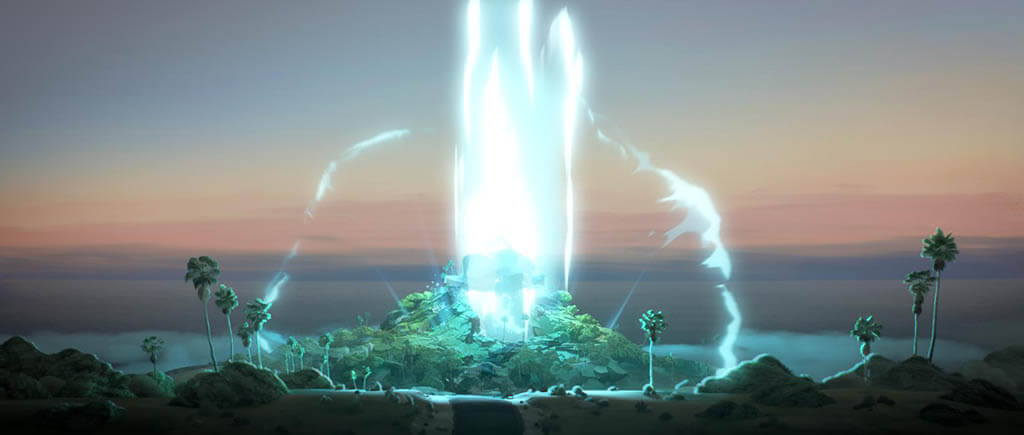
Hand-drawn imperfections and simplification of the scenes and characters were key aspects of the production of The Bad Guys. (Image courtesy of DreamWorks Anima-tion)
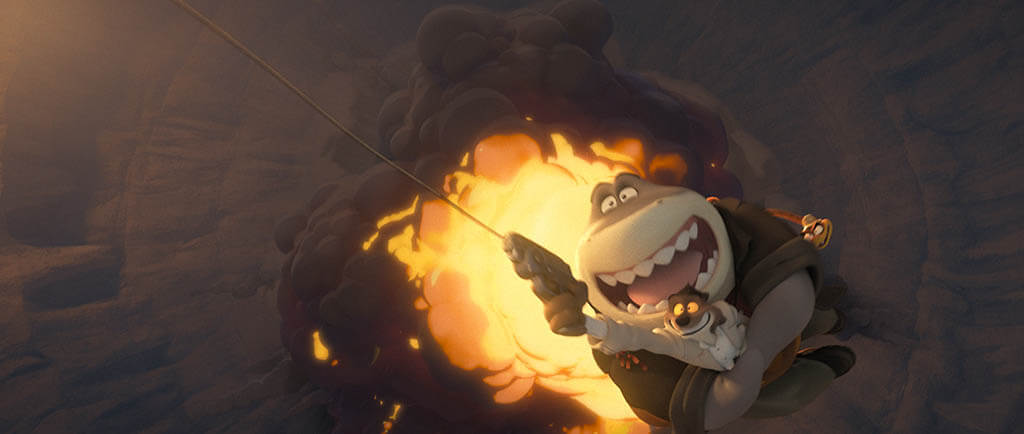
Explosion effects in the film’s third act were realized with multiple techniques on top of simulations. (Image courtesy of DreamWorks Animation)
“One of the biggest challenges,” describes tool developer/TD Marion Debrick, “was to integrate Adobe software and TVPaint in our pipeline which previously only focused on 3D workflows. I had to find a way for our project manager, developed with the Python programming language, to communicate with all the 2D software which did not interpret Python. To achieve that, I built CEP (Common Extensibility Platform) tools that allowed for a user-friendly interface in the software and gave an easy control to the artist.
“We created tooling around incorporating the hand-drawn effects into the engine. This allowed artists to play with the placement of the effects, when they start, and how fast or slow they are. This type of creative freedom really allowed us to elevate not only the 2D workflow, but allowed the animation department to play a greater role in the process of the shot.”
—Dustin Warnock, Creative Director, The Third Floor
“I also had to re-create an Adobe extension manager specific to our pipeline so the artists could easily update their tools after new features are added,” Debrick says. “After the import/export tools were working, I was able to create some other fun tools to help the artists in their drawings for Arcane, such as buttons to clone adjustment layers on multiple layers or blend RGB colors with a linear gamma and a lasso to draw a shape that’s automatically filled.”

The character Jinx in Arcane, featuring a mix of 3D and 2D animation by Fortiche. (Image courtesy of Netflix)

Fortiche needed to develop new 2D and 3D workflows in order to animate Arcane. (Image courtesy of Netflix)
Stylized effects animation for real-time
Animated content being made with game engines – an area on the rise – has also seen a rise in the stylized look and feel of effects for real-time. Director Hasraf ‘HaZ’ Dulull’s animated anime-inspired feature Rift, for example, is currently being made predominantly in Unreal Engine. “When it came to the FX, we created specific shader materials in Unreal Engine to give it that anime look,” Dulull says. “For most of the shots, we used 2D effects libraries, and then in After Effects we combined them to create the desired effect, before rendering them out as PNG with alphas, layering them in DaVinci Resolve, using Fusion FX to help create things like trails and glow effects on top of the EXR final pixel frames from Unreal Engine.”
Dulull adds, “We also took a lot of the 2D elements we created of explosions, smoke and debris hits, and put those on cards as animated textures in Unreal Engine, making them self-emissive to ensure they had their own lighting channel so that they were independent from the main scene lighting. In some instances, we utilized Unreal Engine’s post-processing effects to heighten some of the flatten diffuse look of the stylized FX and lighting as well as the edge lines.”
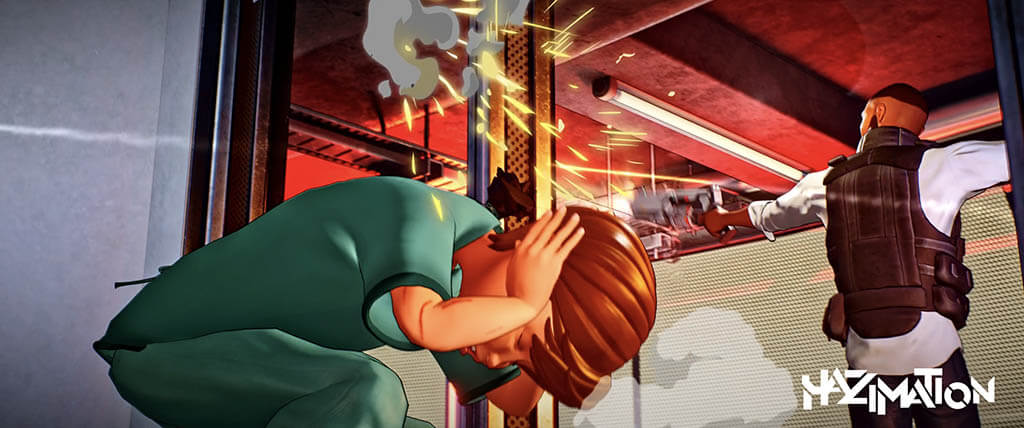
A frame from Rift in which 2D elements are combined with Unreal Engine renders. (Image courtesy Hasraf ‘HaZ’ Dulull)
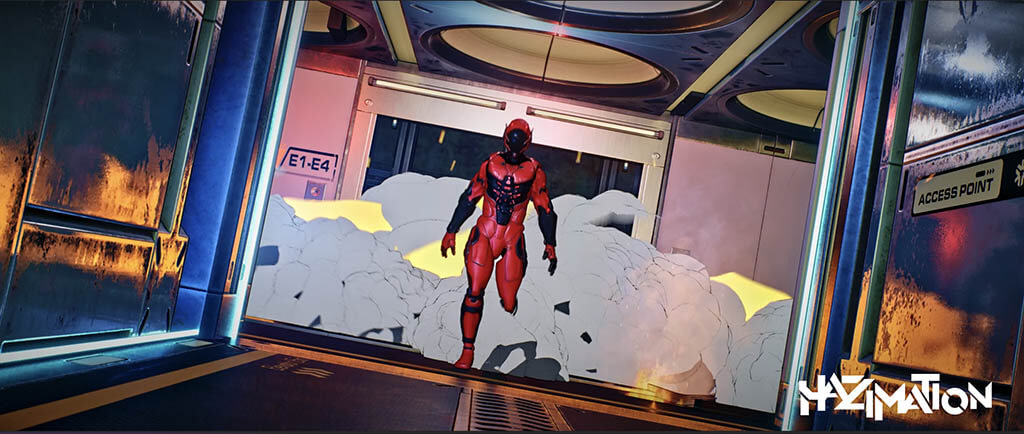
2D elements of explosions, smoke and debris hits were put on cards as animated textures in Unreal Engine. (Image courtesy Hasraf ‘HaZ’ Dulull)
Several animation practitioners have found that their 2D animation skills and assets are heavily sought after in the traditional 3D animation and now real-time space. Brent Forrest, who hails from his own outfit called Forrest Schlage and is also a technical director at Marza Animation Planet Inc., highlights this via his effects packs. Faced with the challenge of making large-scale expressive water effects for a real-time production, Forrest’s team developed a ShapeMeshing system. “It was decided early on that we would use pre-designed elements instead of costly simulations – much the same as we would if we were doing a Flash show. Of course, you can’t just plop 2D elements into a 3D scene. Things get complicated when you incorporate transparency, reflections and objects that cast shadows.”
Forrest continues, “No two assets are made the same way, and it takes a combination of modules to create a usable 3D rig, but they all start with a hand-drawn design. The products of the ShapeMeshing system can be seen in [the animated short film] The Peak by Marza, Like and Follow, made by Tobias Schlage and myself, Miskatonic and UltraDuck made by Arcana Studio, and an upcoming Marza production that will have its world premiere at SIGGRAPH this year.”

To help launch its animation division, The Third Floor made a stylized animated short called Skytribe. (Image courtesy of The Third Floor)

The Third Floor’s animation approach relies on real-time rendering tools inside Unreal Engine. (Image courtesy of The Third Floor)
Meanwhile, visualization studio The Third Floor has also embraced Unreal Engine for its launch of a new animation group and a suite of tools based on custom visualization tools that sit on top of Unreal. To launch the animation venture, The Third Floor made a short called Skytribe. “We wanted to find that balance and blend between the 2D and 3D world,” The Third Floor’s Creative Director Dustin Warnock says. “There were a multitude of approaches we took throughout all the departments that tip the hat to traditional 2D processes. We never wanted to over composite them or blend them too far with the 3D plates. It was important to have the elements remaining inherently flat and two dimensional. We embraced the offsets, varying the timing, and pushing and pulling the elements to strike that balance.”
Warnock adds, “We created tooling around incorporating the hand-drawn effects into the engine. This allowed artists to play with the placement of the effects, when they start, and how fast or slow they are. This type of creative freedom really allowed us to elevate not only the 2D workflow, but allowed the animation department to play a greater role in the process of the shot.”
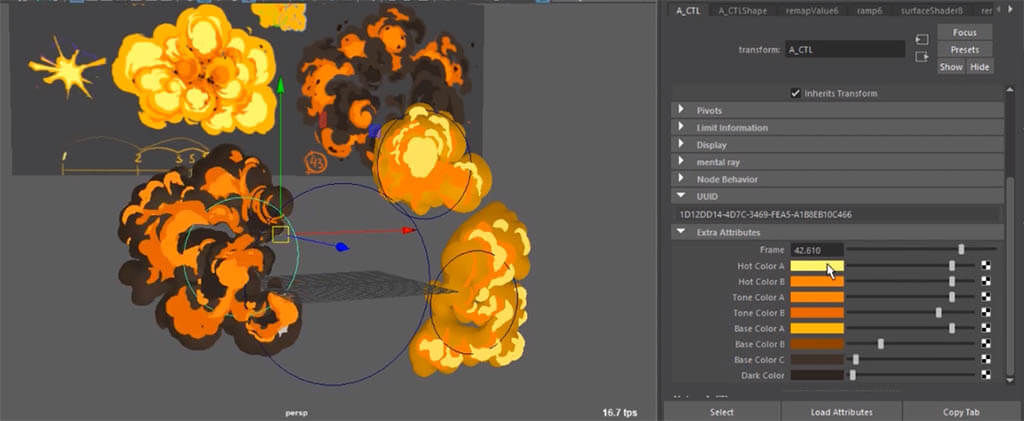
Brent Forrest’s ShapeMeshing system utilizes 2D elements to make 3D sculpts. (Im-age courtesy of Brent Forrest)
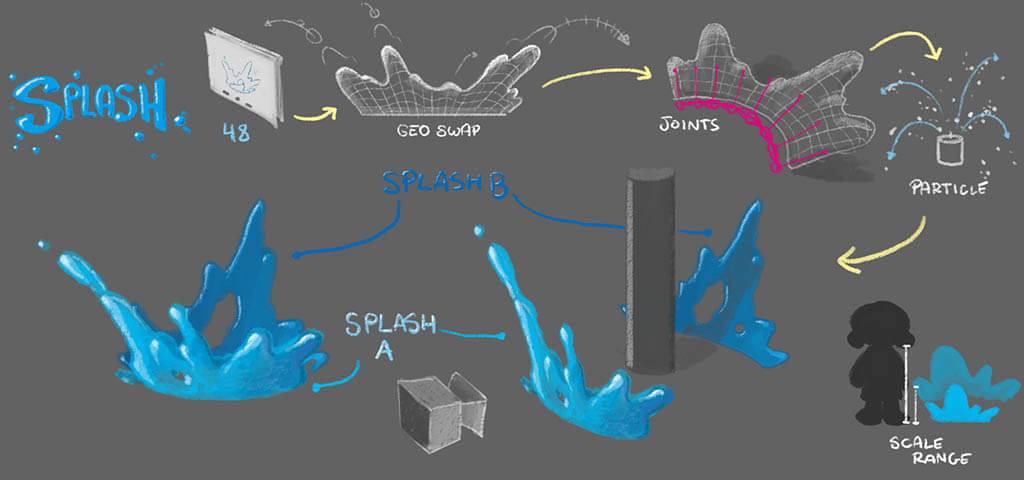
The ShapeMeshing approach allows for things like water-splash elements to be turned into 3D elements in real-time. (Image courtesy of Brent Forrest)
Going for a stylized look
Alongside this explosion in hand-drawn effects animation is an equally large push towards stylization in the final rendering. Often referred to as Stylized Rendering or Non-Photorealistic Rendering (NPR), this approach can be seen in films such as Spider-Man: Into the Spider-Verse and The Mitchells vs. the Machines, the latter of which Lollipop Shaders Founder and Shading Architect Christos Obretenov collaborated on with Sony Pictures Imageworks.
“[Working on Lovecraft Country] was the first time I kept the animation fully at 6K, because I liked the really fine line I could get at that resolution. HD gives a pretty ratty line when you draw on the Cintique, but 6K lets you get a nice variety of electrical bolts working – thick, thin and the occasional big glow when the shape is strong enough and looks nice.”
—Kevin Blank, Visual Effects Supervisor
Hand-drawn effects animation in VFX: still alive and still electric
Some of the hand-drawn lightning or electricity effects animation in projects such as Big Trouble in Little China, Ghostbusters II and Babylon 5 are unforgettable. It turns out that VFX artist Kevin Kutchaver worked on each of those projects, to name a few, and still gets called upon to craft much-desired hand-drawn effects animation to this day, albeit with digital tools. For example, on Lovecraft Country, Visual Effects Supervisor Kevin Blank entrusted Kutchaver to render some electrical energy sparks in a hand-drawn fashion. It was a task he handled mostly in Photoshop. “That was the first time I kept the animation fully at 6K, because I liked the really fine line I could get at that resolution,” Kutchaver advises. “HD gives a pretty ratty line when you draw on the Cintique, but 6K lets you get a nice variety of electrical bolts working – thick, thin and the occasional big glow when the shape is strong enough and looks nice.
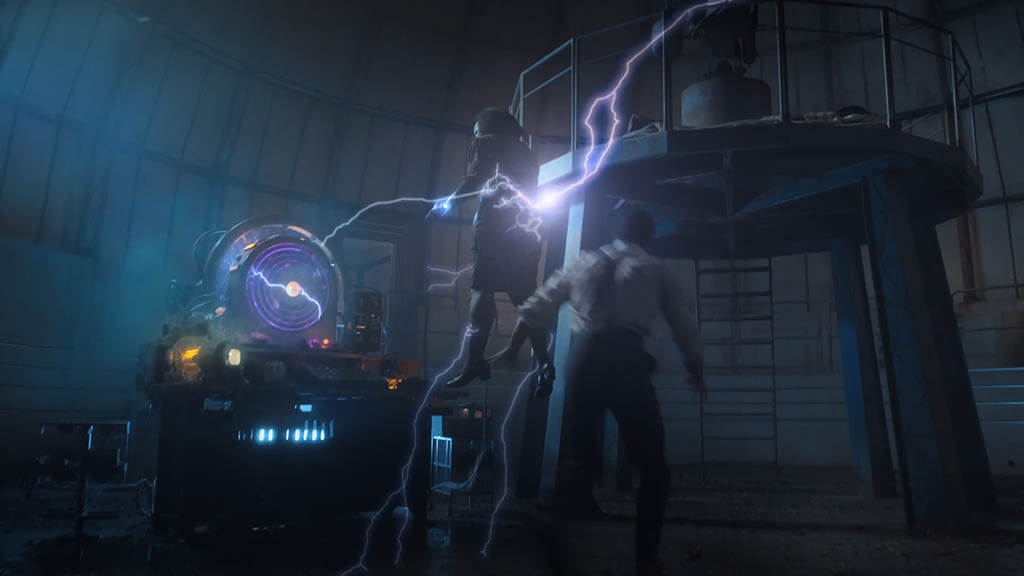
Kevin Kutchaver’s hand-drawn, electric-effects animation for an episode of Lovecraft Country. (Image courtesy of HBO)
“The Umbrella Academy Co-Producer and Visual Effects Supervisor Everett Burrell also contacted me about some character animation for an episode with the animated character, Mr. Briefcase. My wife, Kathy Zielinski, designed and animated the character on the Cintique in Toon Boom Harmony, with clean-up and paint actually done again in Toon Boom by my two daughters. It was a great family project!”
In particular, on Mitchells, Obretenov “worked with the team at Imageworks in developing custom shaders in Open Shading Language (OSL) for their artists to use on the line work and dynamic watercolor illustrative lighting.” He is also Lead Developer on RenderMan’s Stylized Looks, working with Pixar’s RenderMan team.
“Lollipop,” Obretenov says, “tends to contribute during a look/visual development stage to match the client’s concept art over animated shots with custom tools and workflows. If there is a match where our tools and workflows are hitting the concept art over animated sequences, we go onto the next stage where the studio uses the tools for the duration of the project and we support them in finalizing their look of the picture across the entire project.”
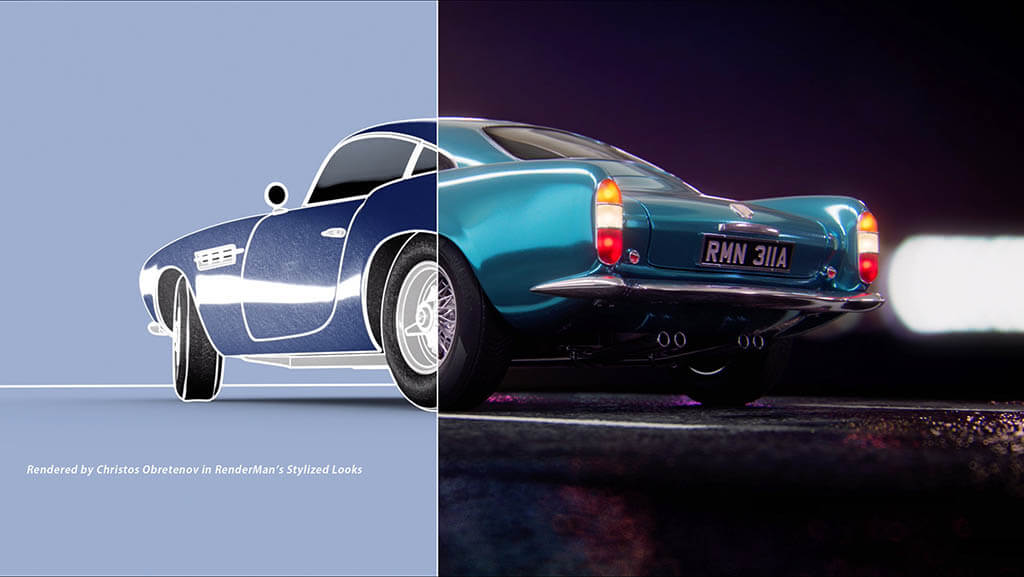
RenderMan’s Stylized Looks was used to render this frame. (Image courtesy of Christos Obretenov)